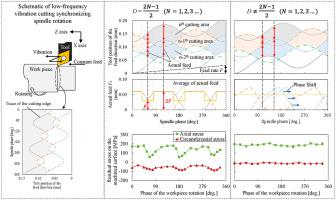Precision Engineering ( IF 3.5 ) Pub Date : 2021-07-07 , DOI: 10.1016/j.precisioneng.2021.06.011 Yo Kamada 1 , Hiroyuki Sasahara 1

|
The turning process is a standard machining process employed in diverse sectors. However, it produces long continuous chips that can affect the efficiency of the process, accelerate the tooling's wear, or damage the machined surface. As a solution, low frequency vibration cutting synchronizing with the spindle rotation has recently been developed as a new machining method in turning operation. It applies vibrations in the tool feed direction and can synchronously control the applied vibrations and the spindle rotation. It can also effectively divide the long continuous chips generated by the turning process and has the potential to reduce thermo-mechanical load on the tool by periodically enabling the tool to leave the workpiece due to the vibrations. Low frequency vibration cutting, the cutting characteristics of which differ from those of conventional turning, induces residual stresses in the machined surface; however, the properties of these stresses have not yet been studied. Residual stress can have both beneficial and negative effects on the fatigue life of products. While compressive residual stress increases the fatigue life of the product, tensile residual stress facilitates the growth of fine cracks on the product's surface and reduces fatigue life. Therefore, it is important to understand the characteristics of the residual stress developed on a machined surface. In this study, an annealed 0.45% C steel bar was machined via straight turning of the vibration cutting process synchronizing with the spindle rotation, and the residual stress on the finished surface was measured. Particular focus was placed on analyzing the effects of the spindle phase on the characteristics of the residual stress inside the machined surface, especially the effects of the number of vibrations per spindle rotation, D, which is a unique parameter defining the vibration condition. Our results revealed that the residual stress varied depending on the position of the finished surface owing to the change in feed with the spindle phase during the process. Furthermore, D was observed to heavily influence the distribution of the residual stress on the finished surface. By means of adjusting its value, the residual stress value could either fluctuate periodically according to the phase of the workpiece or not fluctuate.
中文翻译:

低频振动切削过程中,残余应力通过工件旋转相位周期性波动
车削工艺是不同行业采用的标准加工工艺。但是,它会产生长而连续的切屑,会影响加工效率、加速刀具磨损或损坏加工表面。作为解决方案,最近开发了与主轴旋转同步的低频振动切削,作为车削操作中的一种新加工方法。它在刀具进给方向施加振动,并可以同步控制施加的振动和主轴旋转。它还可以有效地分割车削过程中产生的长连续切屑,并有可能通过周期性地使刀具因振动而离开工件来减少刀具上的热机械负荷。低频振动切割,与传统车削不同的切削特性,在加工表面产生残余应力;然而,尚未研究这些应力的特性。残余应力对产品的疲劳寿命既有有利影响,也有不利影响。残余压应力增加了产品的疲劳寿命,而残余拉伸应力则促进了产品表面细裂纹的生长,降低了疲劳寿命。因此,了解加工表面上产生的残余应力的特性非常重要。在这项研究中,通过与主轴旋转同步的振动切削过程的直线车削加工退火的 0.45% C 钢棒,并测量精加工表面的残余应力。D,这是定义振动条件的唯一参数。我们的结果表明,由于加工过程中进给随主轴相位的变化,残余应力根据精加工表面的位置而变化。此外,观察到D严重影响了成品表面上残余应力的分布。通过调整其数值,残余应力值可以根据工件的相位发生周期性波动,也可以不波动。











































 京公网安备 11010802027423号
京公网安备 11010802027423号